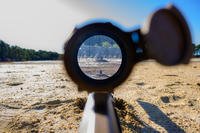Where Hurricane Katrina hit last year, the Air Force wanted to send in Predator drones, to serve as robotic spotters for search-and-rescue teams. The Federal Aviation Administration, still squeamish about drones flying in civilian airspace, negged the plan, however -- too much risk of a crash with a manned aircraft, the bureaucrats said. But a new deal between the flyboys and the FAA should allow the Predators to pitch in, the next time disaster hits.
But a new deal between the flyboys and the FAA should allow the Predators to pitch in, the next time disaster hits.
"A Predator would be limited to flying in restricted airspace at an altitude of 19,000 feet," Defense News reports. "Other aircraft would be expected to stay out of the Predators way."
On short notice, the four disassembled [Predators] and their trailer-like control center could be loaded into a C-17 Globemaster III transport plane or on trucks and dispatched to the disaster region...
From an airfield as far as 150 miles from the search area, a team of two pilots and two sensor operators would handle the Predators takeoffs and landings.
Back at Nellis Air Force Base, Nev., pilots and sensor operators would fly the search-and-rescue phase of the sortie and be in radio or phone contact with recovery operations workers. The Air Force uses a similar split operation for flights over Iraq and Afghanistan.
In a disaster zone, Air Force tactical air control parties and others could use laptop computers hooked up to small antennas to view live Predator images and talk with the crews flying the aircraft.
In addition to sending pictures from its thermal imaging and video cameras, the Predator can also determine location coordinates for rescuers. For example, the Predator can provide an approximate Global Positioning System map coordinate for anything it sees. At night, the aircrafts laser spotter can mark areas for rescuers wearing night-vision goggles.








